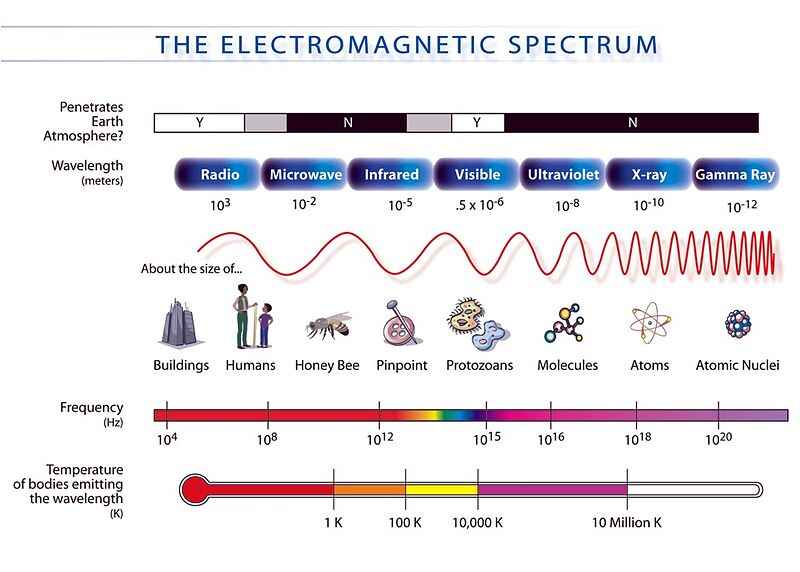Electromagnetic Wave Definition, Production, Propagation, Properties
Electromagnetic wave is a stream of accelerating, energized particles that travel through space when electric and magnetic fields interact. This article discusses electromagnetic wave definition, production, propagation and properties as follows;
-Electromagnetic Wave Definition: 5 Ways to Define Electromagnetic Waves
-How Electromagnetic Waves are Produced and Propagated
-Properties of Electromagnetic Waves
Electromagnetic Wave Definition: 5 Ways to Define Electromagnetic Waves
An electromagnetic wave is is the result of energy transfer that occurs through space, by the action and influence of both magnetic and electrical fields [1]. Examples of electromagnetic waves are x-rays, visible light, microwaves and radio waves.
The above definition lists some examples of electromagnetic waves, in no particular order. Below is is an electromagnetic wave definition that lists all examples electromagnetic waves in order of increasing wavelength;
Electromagnetic waves are radiant energy streams that form a spectrum and can be distinguished in order of increasing wavelength into Gamma Rays, X-Rays, Ultraviolet Light, Visible Light, Infrared Rays, Micro Waves, and Radio Waves.
Based on the wave-velocity formula (v=λ/f=λT), it can be deduced that wavelength varies inversely with frequency and directly with period [2]. The following electromagnetic wave definition further clarifies the inverse proportionality of wavelength and frequency; by listing electromagnetic waves in order of increasing frequency;
An electromagnetic wave is a stream of energetic particles that is part of an electromagnetic spectrum, whose components can be listed in increasing order of frequency, as; Radio Waves, Micro Waves, Infrared Rays, Visible Light, Ultraviolet Light, X-Rays, and Gamma Rays.

Another term for electromagnetic waves is electromagnetic radiation; which is used to refer to the fact that electromagnetic waves can travel across a vacuum by radiation, without need for an intervening, intermediate medium. Next is an alternative electromagnetic wave definition that highlights the types of electromagnetic waves;
Electromagnetic waves are waves resulting from the oscillation of energetic particles like photons, which may be distinguished into various types including; ionizing, non-ionizing, low-frequency (LF), high-frequency (HF), and ultra-high frequency (UHF) EM waves.
Lastly, the concept of electromagnetic wave theory is used as a theme in the electromagnetic wave definition, to explain the production of EM waves;
An electromagnetic wave is the product of accelerating charges generate electrical and magnetic fields along their path of propagation, as described by Clark Maxwell in the EM wave theory [3].
How Electromagnetic Waves are Produced and Propagated
Electromagnetic waves are produced by the dynamic interaction of magnetic and electric fields, which leads to changes in velocity (that is; acceleration) of charges [5].
The charges which produce electromagnetic waves are those which are under the influence of a changing force-field, that causes them (the charges) to continuously oscillate about their mean positions with constantly-changing velocity.
Electromagnetic waves are propagated and transmitted as the energetic influence of the force field radiates in all directions from the mean position of the oscillating charges that have produced EM waves.
This means that the path of travel of an electromagnetic wave coincides with the areal zone of coverage of the force field emanating from vibrating charges. It explains why electromagnetic waves are able to travel through a vacuum, or space, and do not require contact with any medium to move from one point to another.
Electromagnetic waves can travel through space, as well as through materials in their path. This ability is responsible for the use of EM waves for irradiation treatment of cancer, among other similar applications [4].
The direction in which an electromagnetic wave propagates is at right angles to the plane of action, of the magnetic and electric fields (B and E) which it sustains. This is because the electromagnetic wave radiates outward from the mean position of oscillating charges, which is usually aligned with the plane of field action.
A concept that explains EM wave direction is the Right-Hand-Rule; which illustrates the acting-planes of the electric and magnetic fields relative to the waves, using the thumb and other fingers of a hand.

Properties of Electromagnetic Waves
Properties of electromagnetic waves are;
1). Contactless propagation (through a vacuum)
2). Travel at the speed of light (3 × 10^8 m/s)
3). Can interfere with other electromagnetic waves
4). Exhibit reflection, refraction, diffraction
5). Posses electrical and magnetic field potentials
6). Are transverse (perpendicular-vibrating) waves
7). Can penetrate through materials in their path of propagation
Conclusion
An electromagnetic wave is a stream of energy that propagates through a vacuum under the influence of changing electric and magnetic fields. The concept behind electromagnetic waves is in fact similar to that behind electricity, electric motors and generators.
Electromagnetic waves are produced and propagated by the interaction of perpendicular electric and magnetic fields, which causes charged particles to oscillate with changing velocity.
Properties of electromagnetic waves are; contactless propagation, speed of light, interference, reflection, refraction, diffraction, electric and magnetic field potentials, transverse mode of propagation, and ability to penetrate through obstructing media.
References
1). Brodie, G. (2019). "Energy Transfer from Electromagnetic Fields to Materials." Electromagnetic Fields and Waves. Available at: https://doi.org/10.5772/intechopen.83420. (Accessed 31 March 2023).
2). Bulus, U. (2014). "Center Wavelength Design Frequency [Antenna Designer's Notebook]." in IEEE Antennas and Propagation Magazine, vol. 56, no. 5, pp. 167-169, Oct. 2014, Available at: https://doi.org/10.1109/MAP.2014.6971932. (Accessed 31 March 2023).
3). Longair, M. (2015). "'A paper ⋯i hold to be great guns': A commentary on Maxwell (1865) 'A dynamical theory of the electromagnetic field'". Philosophical Transactions of The Royal Society A Mathematical Physical and Engineering Sciences 373(2039). Available at: https://doi.org/10.1098/rsta.2014.0473. (Accessed 31 March 2023).
4). Makroupoulou, M. I. (2016). "Cancer and electromagnetic radiation therapy: Quo Vadis?" Available at: https://doi.org/10.48550/arXiv.1602.02077. (Accessed 31 March 2023).
5). Shadid, W.; Shadid, R. (2021). "Electric Model for Electromagnetic Wave Fields." IEEE Access PP(99):1-1. Available at: https://doi.org/10.1109/ACCESS.2021.3090862. (Accessed 31 March 2023).



